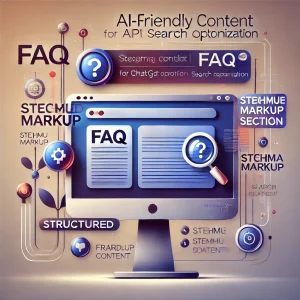
ChatGPT Search Optimization: Building AI-Friendly FAQs and Answer Sections
Introduction
As ChatGPT and other AI-driven search models become more prevalent, crafting AI-friendly FAQs and Q&A sections is an essential strategy. These sections are ideal for capturing user queries, and they increase your chances of being selected for ChatGPT responses. This guide will walk you through creating effective FAQ and answer sections optimized specifically for ChatGPT’s search function.
1. Identify High-Value Questions for Your Audience
The first step is to choose questions that reflect your audience’s primary concerns. This alignment makes your FAQs directly relevant, increasing the chances that ChatGPT will select them in response to user queries.
- Tip: Use Google’s “People Also Ask,” Quora, and forums to find recurring questions. If you have access to your own customer service or social media data, use these insights to craft FAQs directly from common user inquiries.
2. Structure Questions with Schema Markup
Schema markup (structured data) is crucial for making your FAQs AI-friendly. FAQ schema helps search engines understand your content, enabling ChatGPT to pull it directly into its responses.
- How-To: Use JSON-LD to add FAQ schema markup to your content. This gives AI models a structured view of your Q&A format.
- Example: If you run a skincare website, questions like “How often should I use retinol?” can be tagged with schema to make the content highly retrievable.
3. Write Direct, Definitive Answers
In the world of AI-driven search, clarity is king. Write direct answers that don’t require additional context. If a question has multiple answers, start with the most straightforward option, then offer alternatives if needed.
- Example: If the question is “What’s the best time to post on social media?” your answer could start with, “The best time to post on social media is between 10 am and 1 pm for most platforms. However, it can vary based on audience behavior.”
4. Incorporate Conversational Language
ChatGPT responds well to conversational language, so avoid overly formal tones or complex industry jargon. Answer questions as if you’re speaking directly to a user, maintaining a friendly, approachable tone.
5. Keep Each Answer Short and Skimmable
Use concise answers, ideally under 40 words. For more complex questions, create bullet points or short lists that can be quickly scanned. This structure not only helps ChatGPT’s AI parsing but also improves user readability.
Conclusion
Optimizing FAQs and answer sections for ChatGPT involves choosing high-value questions, using structured data, and crafting concise, direct answers. By implementing these techniques, you’ll improve your visibility within ChatGPT’s AI-driven search results, providing direct value to users seeking answers.
